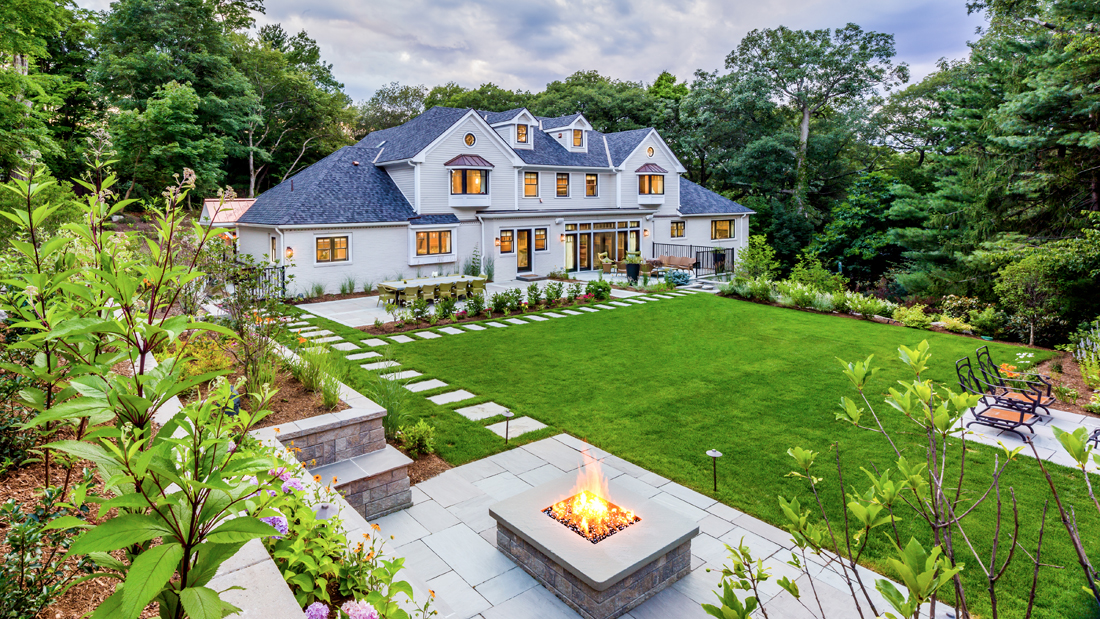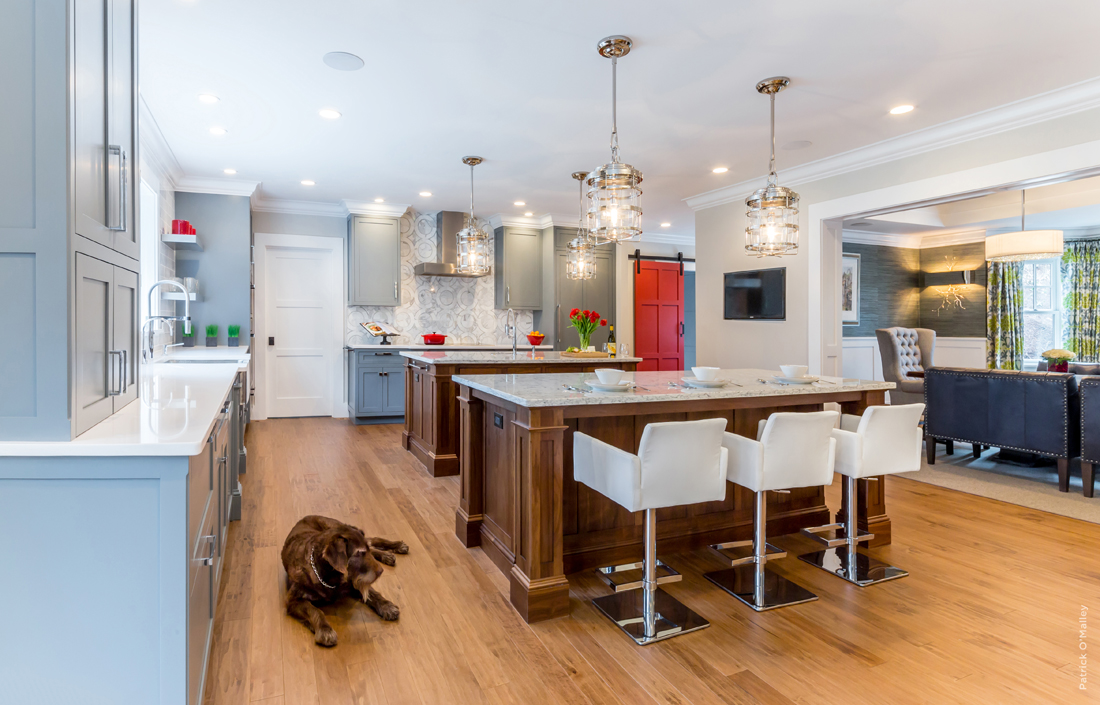by Glenn M. Travis, Principal, GMT Home Design Inc.
In our previous post, we looked at the history of the classical Colonial style New England home.
We're often brought in to help modern homeowners get more space, convenience, and sustainability, without losing that look and feel of local history.

New England, in style! Homeowners tasked GMT Home Designs with remodeling their ranch-style house into this stately, modern Georgian Colonial.
Updating the Colonial exterior
For starters, there are some excellent ways to update the exterior, and even improve the function, of a Colonial without changing the essential layout.
The front door. Let's start simple: One common way to update a Colonial style New England home is to add a pop of color to the front door. A bright red or blue door can really make the home stand out and add some personality. I also like to have front doors shown with a natural wood grain that matches the wood grain on the garage doors. This is a fairly common approach. Some homeowners go further by painting the shutters or window frames to match.
Landscaping. Another idea is to update the landscaping. Adding some colorful flowers and plants can really enhance the curb appeal of the home. If you have the space, adding a small garden or a vegetable patch can be a great way to add some charm and functionality. Hardscaping, even simple steps like adding brick or cobblestone pathways, adds a clean modern appeal in Colonial style. Another great choice in New England for hardscape is bluestone in various patterns.
Molding. Later Colonial styles often have more elaborate molding under the roofline or other exterior details; this can be an addition to older Colonial homes that 'updates' or refreshes the look, but by enhancing the classic style.
Windows. In terms of more significant updates: The older your Colonial home is, the more likely it is to have small windows. This is a great first place to look for improvement; consider larger window frames that will increase interior light and refresh the exterior, while eliminating drafts and employing top-line energy-efficient glass. The key to these changes is making sure the scaling and order make sense, so the house keeps a balanced look — experience with remodeling New England-style homes makes a difference!
Siding/finish. Some owners take the approach of adding a modern twist by replacing the traditional wood siding with a sleek metal or concrete finish. That keeps your Colonial shape but definitely changes the aesthetic of the home — depending on the surrounding houses, that may help you blend in, or stand out.
Entryway and porch. Beyond those steps that are primarily cosmetic changes to the exterior of a Colonial, the front porch — or typically for older New England homes, the lack of one — is a natural place for an update. Even a small new entryway addition can break up the relatively flat look of the home's front, and create a more welcome entryway. If the front door is bumped out, this can provide useful space for storage hooks and benches. This is a favorite type of GMT Home Design project, adding functionality for modern living as well as dramatically improving curb appeal, all in keeping with local style.
Extending the roofline from such an entry across the full front of the Colonial is a nice way to provide covered outdoor seating areas.

Backyard landscaping expands a home's modern Colonial look-and-feel with even more space for play, entertainment, or just enjoying New England's seasons.
Colonial interior updates and remodeling ideas
In the main living space inside a Colonial, owners have many options for remodeling projects and additions to make the home work better for their modern lifestyle or family life.
Skylights. A very simple update that can have a dramatic effect on the interior is to add one or more skylights. This can really brighten up the home's interior with some natural light, without altering the roofline or the interior space. Better light is a frequent need in older Colonials with smaller rooms and/or smaller windows. In some homes or rooms, adding a sun tunnel is another, less costly way to bring natural light to interior rooms.
Kitchen. A modern kitchen with updated appliances, newer and more open cabinetry, and improved counter and island space is a popular choice. Many homeowners today are matching either stainless steel or black appliances, especially gas stoves and ranges, with common rustic Colonial features like exposed beams and calm, muted paint choices. 'Colonial style cabinets' are another option for bringing in a more rustic element.
Bathrooms. The possibilities for updating Colonial bathrooms are endless. New sinks, fixtures, vanities, and tubs can be vintage style with modern comfort and water efficiency. Older Colonial bathrooms tend toward the smaller side, but a larger window or skylight can add light and a sense of spaciousness without moving any walls, and modern bathroom fixture options like floating vanities or open shelves can do the same, making the whole space work better.
Basement. If your home has a basement, that's a great place to think about adding living space. Turn an unfinished basement into a playroom, family room, movie room (or all three). Keep in mind the return on investment for lower-level spaces differs compared to 1st or 2nd floor conditioned spaces.
Additions. An extra living space, whether bedroom, seasonal room, or office can also enhance the functionality of the home while still maintaining its classic charm. It is sometimes challenging to open up the floor plan of a Colonial, particularly when given a fixed central chimney and staircase. On the other hand, an advantage of Colonials in this regard lies in their boxy, symmetrical shape, which creates options for the direction and placement of a new seasonal room or a full addition.

An updated kitchen blends contemporary sophistication with classic colonial materials and colors. (Great dogs are also timeless.)
In our Colonial additions, we pay special attention to not only the building materials but also rooflines, doorways, and window placement to give the entire house a harmonious, classical look.
If you own an official heritage home or some other historical designation, your state or town may place some restrictions or special requirements on remodeling — of course you likely understood that if you purchased the home. That said, there are plenty of great options for every Colonial homeowner to increase value, energy efficiency, curb appeal, functionality and more, all within the Colonial style.
About the author: GMT Home Designs founder Glenn M. Travis has lived and worked in New England all his life, with 30+ years' experience in architectural design. Learn more about us.
